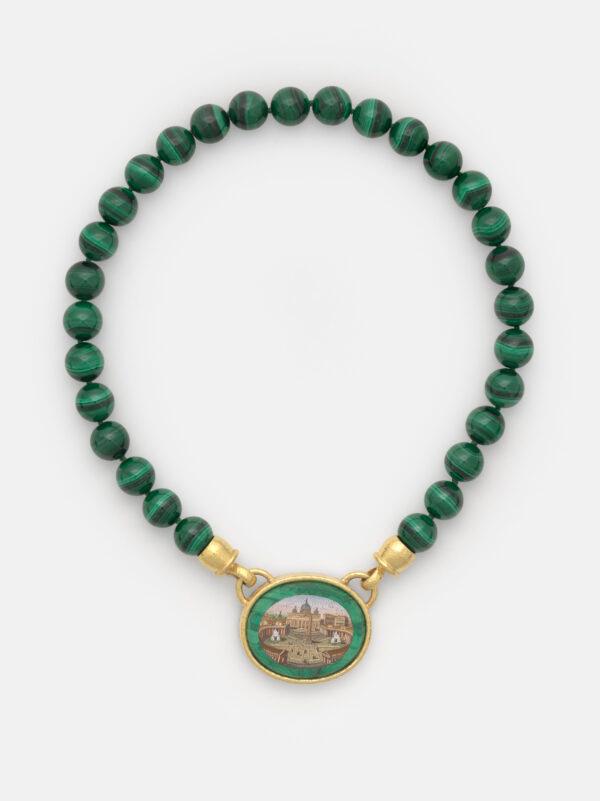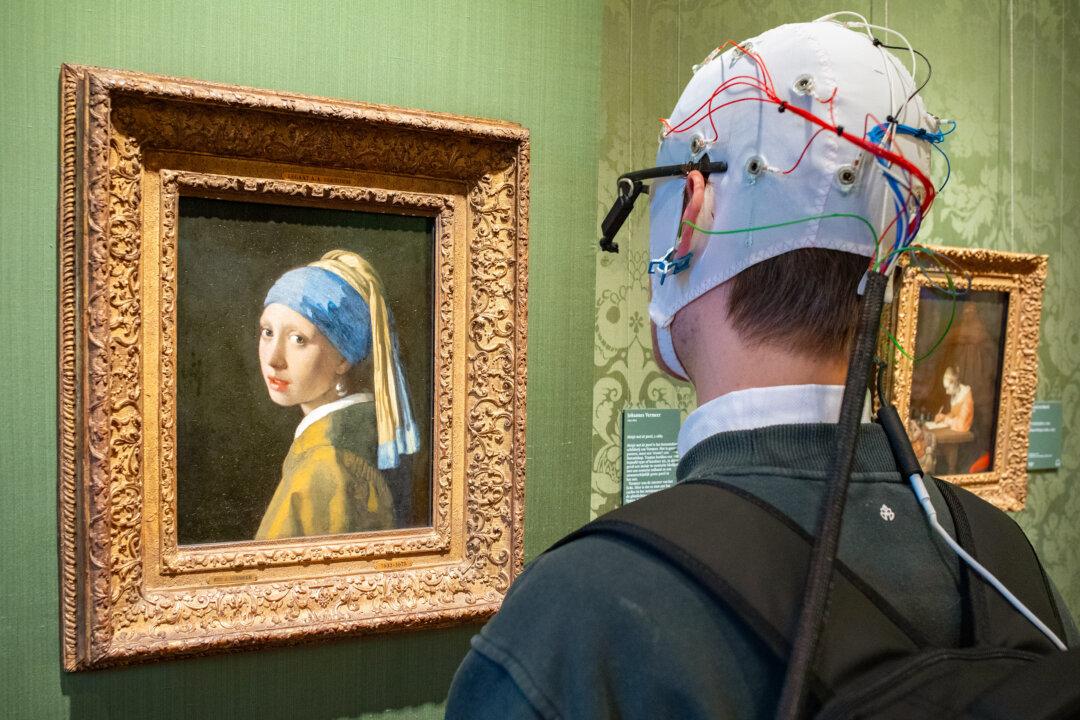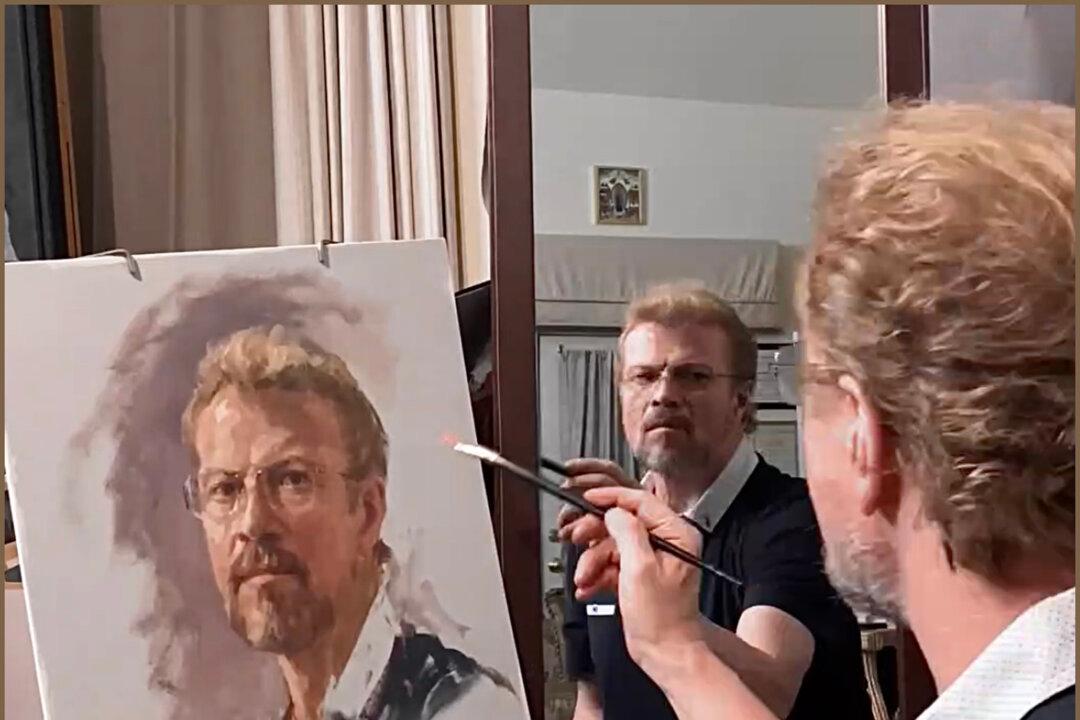Unique 18th- and 19th-century tourist treasures, many with a twist, are currently on display in the exhibition “A Return to the Grand Tour: Micromosaic Jewels From the Collection of Elizabeth Locke,” at the Gibbes Museum of Art in Charleston, South Carolina.

"St. Peter’s Square, Rome," 19th century. Micromosaic reset in gold as a pendant, with malachite border; 1 1/4 inches by 1 5/8 inches, suspended on 1/2 inch malachite bead necklace; 17 inches. Collection of Elizabeth Locke. Travis Fullerton/Virginia Museum of Fine Arts
Made from teeny-tiny pieces of colored glass, micromosaics make up the most amazing, almost painterly pictures depicting all manner of things. The exhibition’s micromosaics include quintessential scenes of Rome: the people, landscapes, and, of course, famous architecture such as the Colosseum, St. Peter’s Square, and the Roman Forum.

"Peasant Man With Walking Stick, Rome," 19th century, after etchings by Bartolomeo Pinelli. Micromosaic reset in wide, hammered gold bangle with rolled edges and side black jade cushions with gold triads; 1 3/8 inches by 2 1/2 inches by 2 3/8 inches. Collection of Elizabeth Locke. Travis Fullerton/Virginia Museum of Fine Arts

"Wilderness, Rome," 19th century. Micromosaic reset in gold as a pendant, with gold balls and granulation; 1 3/4 inches by 2 inches. Collection of Elizabeth Locke. Travis Fullerton/Virginia Museum of Fine Arts
Some of the best micromosaics contain an astounding 3,000 to 5,000 tiles per square inch. The exhibition’s micromosaics contain up to 1,400 tiles per square inch.

"Doves of Pliny," 19th century, by Gioacchino Barberi. Micromosaic reset in black plaque; 2 1/8 inches by 3 1/8 inches. Collection of Elizabeth Locke. Travis Fullerton/Virginia Museum of Fine Arts
A Jeweler’s Love for Micromosaics
Locke, a contemporary jewelry designer, first fell in love with micromosaics while living in Florence, Italy. In 1989, she bought her first micromosaic: a small rectangle of the Temple of Vesta. Locke reset the piece in 19-karat hand-hammered gold and cabochon stones, in a style influenced by neoclassical design.
"Parrot, Rome," 19th century. Micromosaic reset in gold as a pendant, with four sets of 1/4-inch tsavorite and 1/8-inch demantoid garnets on bezel; 2 inches by 1 3/4 inches. Travis Fullerton/Virginia Museum of Fine Arts
Locke has now amassed a collection of over 100 pieces, 92 of which are featured in the exhibition. Here’s the exhibition’s twist: She has reset most of the micromosaics in her renowned neoclassical style.
Locke is tapping into an old tradition. From the 17th to the 19th century, wealthy Europeans on their Grand Tour of Italy used to buy micromosaics as jewelry and souvenirs. Sometimes the micromosaics would be inlaid into furniture, snuff, or decorative boxes. An example of the last is in the exhibition.

"Colosseum, Rome," 19th century. Micromosaic reset in a metal box detailed with enamel paint; 3/4 inches by 1 3/4 inches by 1 1/2 inches. Collection of Elizabeth Locke. (Travis Fullerton/Virginia Museum of Fine Arts

"Colosseum, Rome," 19th century. Micromosaic reset in a metal box detailed with enamel paint; 1 3/4 inches by 1 3/4 inches by 1 1/2 inches. Collection of Elizabeth Locke. Travis Fullerton/Virginia Museum of Fine Arts
Many Italian micromosaics were sent straight to jewelers in Paris and London to be set into jewelry. Micromosaic jewelry fell out of favor in the 1870s.
Making Micromosaics
According to a video from the Victoria and Albert Museum, a micromosaic artist fuses or combines together different colored glass mosaic tiles to create an assortment of colors, unique in size and shape. Then the artist melts the tiles in a metal crucible and pulls the molten glass into long canes that solidify when cooled. The artist scores the canes and carefully snaps them into tiny, oblong pieces.Then the artist prepares a metal base with paste, into which he or she then marks the design. Using tweezers, the artist then painstakingly places each teeny-tiny mosaic piece onto the paste.

"Walking Butterfly," 19th century, attributed to Giacomo Raffaelli. Micromosaic reset in gold as a pendant, with gold bezel, hinged bale; 1 3/8 by 1 3/8 inches. Collection of Elizabeth Locke. Travis Fullerton/Virginia Museum of Fine Arts
Once the picture is complete, the artist polishes the micromosaic by applying a couple of wax coatings and sanding to smooth the surface.
To find out more about the exhibition “A Return to the Grand Tour: Micromosaic Jewels From the Collection of Elizabeth Locke,” which runs until Jan. 10, 2021, at the Gibbes Museum of Art, visit GibbesMuseum.org
This exhibition is organized by the Virginia Museum of Fine Arts, Richmond.






